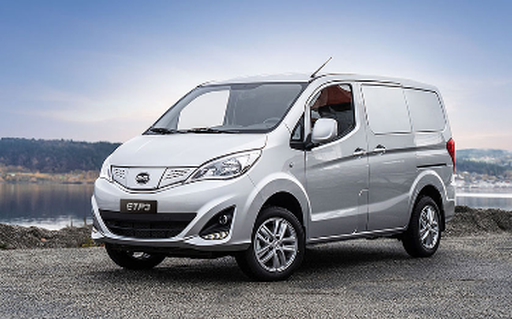BYD ETP3 vs Peugeot Partner – Which car suits you better?
Two cars, one duel: BYD ETP3 meets Peugeot Partner.
Which one wins in performance, efficiency and value for money? Find out now!
Costs and Efficiency:
Price and efficiency are key factors when choosing a car – and this is often where the real differences emerge.
Peugeot Partner has a decisively advantage in terms of price – it starts at 22400 £, while the BYD ETP3 costs 31600 £. That’s a price difference of around 9231 £.
As for range, the Peugeot Partner performs noticeable better – achieving up to 354 km, about 121 km more than the BYD ETP3.
Engine and Performance:
Power, torque and acceleration are the classic benchmarks for car enthusiasts – and here, some clear differences start to show.
Both models deliver identical power – 136 HP each.
In terms of top speed, the Peugeot Partner performs decisively better – reaching 183 km/h, while the BYD ETP3 tops out at 100 km/h. The difference is around 83 km/h.
There’s also a difference in torque: Peugeot Partner pulls distinct stronger with 300 Nm compared to 180 Nm. That’s about 120 Nm difference.
Space and Everyday Use:
Cabin size, boot volume and payload all play a role in everyday practicality. Here, comfort and flexibility make the difference.
Seats: Peugeot Partner offers convincingly more seating capacity – 5 vs 2.
In curb weight, Peugeot Partner is distinct lighter – 1329 kg compared to 1640 kg. The difference is around 311 kg.
In maximum load capacity, the Peugeot Partner performs slightly better – up to 4000 L, which is about 500 L more than the BYD ETP3.
When it comes to payload, Peugeot Partner clearly perceptible takes the win – 991 kg compared to 780 kg. That’s a difference of about 211 kg.
Who wins the race?
The Peugeot Partner proves to be dominates this comparison and therefore becomes our DriveDuel Champion!
Peugeot Partner is the better all-rounder in this comparison.
Peugeot Partner
BYD ETP3
The BYD ETP3 is a versatile electric van that seamlessly blends functionality with environmental consciousness. Its modern design is complemented by a spacious interior, making it ideal for both urban deliveries and day-to-day personal use. Advanced technology features ensure a smooth and efficient driving experience, setting a new standard in the electric vehicle market.
details @ press.bydauto.be
@ press.bydauto.be
Peugeot Partner
The Peugeot Partner is a versatile and practical vehicle, ideal for both urban and rural settings. Its spacious interior and adaptable seating make it a popular choice for families and businesses alike. With a focus on reliability and efficiency, the Partner is well-suited to meet the demands of everyday transport.
details

|
|
|
|
|
Costs and Consumption |
|
|---|---|
|
Price
31600 £
|
Price
22400 - 33800 £
|
|
Consumption L/100km
-
|
Consumption L/100km
5.2 - 6.3 L
|
|
Consumption kWh/100km
-
|
Consumption kWh/100km
17.40 kWh
|
|
Electric Range
233 km
|
Electric Range
354 km
|
|
Battery Capacity
-
|
Battery Capacity
-
|
|
co2
0 g/km
|
co2
0 - 143 g/km
|
|
Fuel tank capacity
-
|
Fuel tank capacity
53 - 61 L
|
Dimensions and Body |
|
|---|---|
|
Body Type
Cargo Van
|
Body Type
Cargo Van
|
|
Seats
2
|
Seats
2 - 5
|
|
Doors
5
|
Doors
4 - 5
|
|
Curb weight
1640 kg
|
Curb weight
1329 - 1813 kg
|
|
Trunk capacity
-
|
Trunk capacity
1800 L
|
|
Length
4460 mm
|
Length
4403 - 4753 mm
|
|
Width
1720 mm
|
Width
1848 mm
|
|
Height
1875 mm
|
Height
1796 - 1812 mm
|
|
Max trunk capacity
3500 L
|
Max trunk capacity
3300 - 4000 L
|
|
Payload
780 kg
|
Payload
611 - 991 kg
|
Engine and Performance |
|
|---|---|
|
Engine Type
Electric
|
Engine Type
Electric, Diesel, Petrol
|
|
Transmission
Automatic
|
Transmission
Automatic, Manuel
|
|
Transmission Detail
-
|
Transmission Detail
Reduction Gearbox, Manual Gearbox, Automatic Gearbox
|
|
Drive Type
Rear-Wheel Drive
|
Drive Type
Front-Wheel Drive
|
|
Power HP
136 HP
|
Power HP
102 - 136 HP
|
|
Acceleration 0-100km/h
-
|
Acceleration 0-100km/h
11.20 s
|
|
Max Speed
100 km/h
|
Max Speed
135 - 183 km/h
|
|
Torque
180 Nm
|
Torque
205 - 300 Nm
|
|
Number of Cylinders
-
|
Number of Cylinders
3 - 4
|
|
Power kW
100 kW
|
Power kW
75 - 100 kW
|
|
Engine capacity
-
|
Engine capacity
1199 - 1499 cm3
|
General |
|
|---|---|
|
Model Year
2023
|
Model Year
2024 - 2025
|
|
CO2 Efficiency Class
A
|
CO2 Efficiency Class
A, E
|
|
Brand
BYD
|
Brand
Peugeot
|
What drive types are available for the BYD ETP3?
The BYD ETP3 is offered with Rear-Wheel Drive.
The prices and data displayed are estimates based on German list prices and may vary by country. This information is not legally binding.
